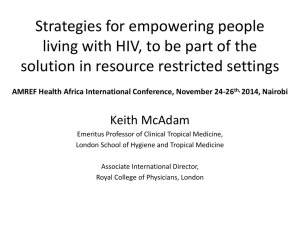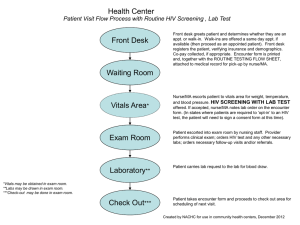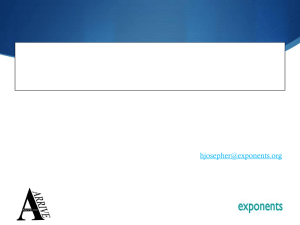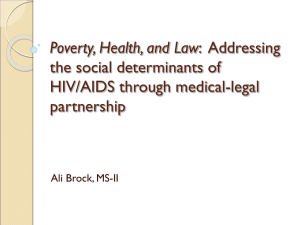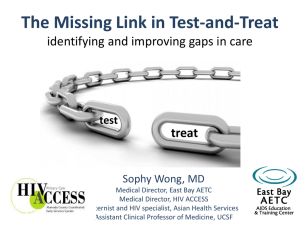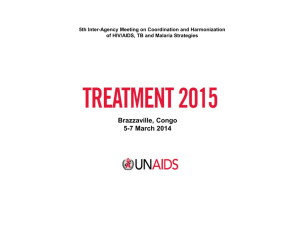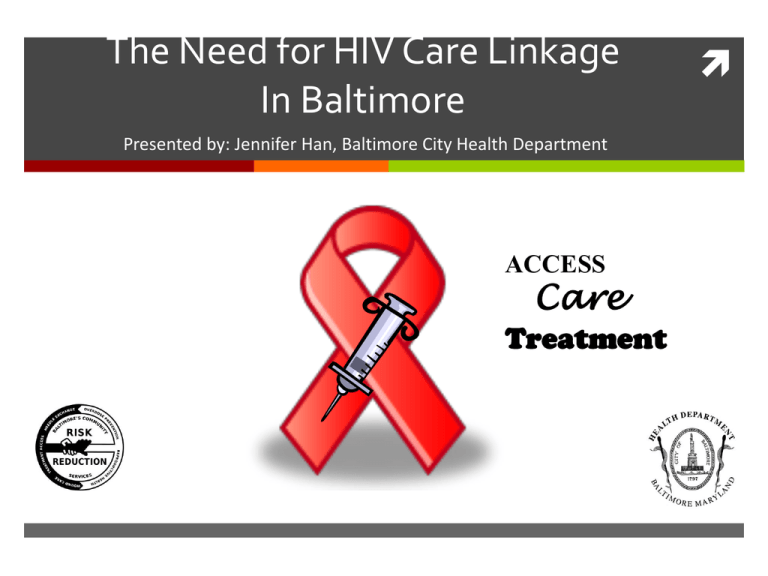
The Need for HIV Care Linkage
In Baltimore
Presented by: Jennifer Han, Baltimore City Health Department
ACCESS
Care
Treatment
Background
Syringe exchange (SEPs) are cost-effective and evidence-based
interventions that not only reduce HIV and Hepatitis C
transmission, but can serve as a bridge for injection drug users
(IDUs) to access medical care and drug treatment1
The National HIV/AIDS Strategy for the United States stresses
the importance of increasing access to care and improving health
outcomes for people living with HIV by facilitating linkages to
care2
HIV Care Among Injection Drug Users
IDUs receive a disproportionately high amount of hospital
resources compared to other HIV-positive groups3
Despite this, studies have demonstrated that IDUs have lower
uptake of HIV care and treatment, including antiretroviral
therapy than other HIV-infected populations4
Consequences of Inadequate HIV Care
Missed care appointments are associated with5:
Poor antiretroviral therapy (ART) adherence
Increased HIV drug resistance
Higher mortality rates
Failure to suppress viral load
Decreased immune function
High-risk sexual behavior
Proposed Strategy
Incorporating HIV testing and treatment into harm reduction
services such as SEPs have been identified as a strategy for
improving access to HIV care among IDUs6
This presentation examines both the potential and need for HIV
care linkage among clients of the Baltimore City Health
Department (BCHD) run SEP
Baltimore Needle Exchange Program
Started in 1994 as a pilot 1:1 exchange program
Run by health department
Expanded services beyond needle exchange
Client electronic records became available in 2008
Prior to 2008, BNEP was:
Anonymous
Paper and pen method of record keeping
Currently, BNEP is the only confidential syringe exchange in the
country
Introducing the location of 2014
National Harm Reduction
conference…
HIV Care Linkage Process
Insight
• 3,491 NEP
clients
STD MIS
• Check to
see HIV
status
ETO
• Check to
see if
connected
to HIV
care
Insight
NEP electronic database
Used for:
Client registration
Records all client visits
Data reports
Step 1: Generate NEP client list
Step 2: Check HIV test records for NEP clients
STD MIS
Database of HIV status and treatment records for individuals
who test in Baltimore City
Step 1: Searched for NEP clients in STD MIS by name, birthday,
etc.
Step 2: Created separate lists for matches, possible matches,
and no matches
Step 3: For those with matches and possible matches, pulled
up their HIV status and testing records
ETO Database
Database of individuals who have accessed any services
funded by Ryan White
Step 1: Provided list of HIV+ clients to Ryan White staff to
check in their database if client is linked to care
Step 2: Also provided two other lists
NEP clients whose last HIV test was negative
NEP clients with unknown HIV status
Step 3: Obtain HIV care status for NEP clients that were
found in ETO
HIV status among NEP clients
261 HIV +
3,491 clients
1492 HIV -
11 are actually
HIV+
1738 w/
unknown HIV
status
66 are actually
HIV+
HIV prevalence among NEP clients
Year
HIV Prevalence**
2004
4/20 = 20%
2005
11/74 = 14.9%
2006
12/125= 9.6%
2007
19/136= 14%
2008
26/206= 12.6%
2009
37/352= 10.5%
2010
94/681= 13.8%
Overall prevalence for NEP
clients is 343/3491 = 9.8%
Denominator includes
clients with unknown HIV
status and with no recent
HIV test
**Denominator is the number of clients whose last HIV test was in year X
Prioritizing Active Clients for HIV Care Linkage
Active clients = # of clients with at least one visit to NEP in the
last year
As of January 24, 2011, there were 1,251 active NEP clients
Of the 1,251 clients, 144 (11.5%) are HIV+
Final step: Submitted list of HIV+ clients to Maryland State
Health Department to check HIV care status
NEP Client Characteristics (n=1,251)
Sex
•
65.8% male
Number of visits to NEP in 2011
per client
•
34% female
•
26.1% had 1 visit
•
28.2% had 2-4 visits
•
20.9% had 5-10 visits
•
15.3% had 11-24 visits
•
9.5% had 25+ visits
Race
•
59.2% Black
•
38.6% White
Average age is 43.2 years old
HIV status
•
11.5% HIV+
•
55.9% HIV-
•
31.9% Unknown status
HIV Care Linkage Program
Collaboration between NEP and Ryan White programs
HIV Care navigators/advocates accompany clients to their
appointments
Strategies:
Shared information to confirm clients’ HIV status and medical care
history
Provided flyers about HIV Care Linkage Program on SEP mobile units
Inserted alerts into a database for SEP clients who have fallen out of
care
Field records are generated to locate HIV+ clients who have fallen out
of care
ACCESS
Care
Treatment
Process Flow for Linking a HIV+ NEP clients
1.
2.
3.
4.
Client comes to SEP
SEP staff member enters visit into database; an alert pops up
Staff asks client about his/her HIV care status
If client is out of care and wants to be linked to care, the HIV
Care Linkage Team is notified immediately by phone and a field
record is generated.
5. A member of the HIV Care Linkage Team picks the client up and
accompanies him/her to their first 2 appointments
6. The client receives a small incentive for keeping each of the 2
appointments
7. Outcome of the field record is logged as “linked to care.”
Outcomes
Client Characteristics
N (%)
HIV Care Status
In Care*
Incarcerated and in care
Not In Care
Deceased
67 (46.5)
14 (9.7)
62 (43.1)
1 (0.7)
Inpatient hospitalizations** (n=62)
35 (56.5)
Recent Visit to SEP (since September 2011)
67 (67.4)
Median viral load (n=47)
Median CD4 count (n=74)
3,257
313
*Clients were categorized as “in care” if the visit occurred within the past 6 months
*All inpatient hospitalizations were among those not in care
HIV Care Status Breakdown and Program Outcomes
1 Deceased
14
Incarcerated
81 In Care
6 Successful
Linkages
144 HIV+
35 had
Inpatient Care
62 Not In Care
3 In Progress
8 Field Records
5 Refusals
Summary of Outcomes
Among the 144 HIV+ SEP clients, 43.1% are not receiving HIV
care, of which nearly half have had a inpatient hospitalization as
their source of HIV care
Among the field records that were generated by BCHD’s HIV
Care Linkage Team, 55% resulted in successful linkages to HIV
care.
67.4% of HIV+ clients had had a more recent visit to the SEP
(since September 2011).
Limitations
Data discrepancies between databases
Database limitations
Lag period of reporting
Data is already outdated
New NEP clients are added daily
HIV testing/Ryan White data
Challenges
Manual labor
Took approximately 6 months for interns to complete cross
checking NEP clients in STD MIS
Took 1 month for Ryan White to check clients in Ryan White
database
Multiple databases that do not communicate with one
another
Dealing with inaccurate client information
Missing information (HIV tests, care status, etc)
Lag period for reporting
Assessment on the barriers to HIV Care
engagement among NEP clients
Target Population:
All HIV-positive Needle Exchange
Program (NEP) clients who are
active users of the NEP van
(n=144)
Survey Sample 1:
NEP Clients
(n=4)
Survey Sample 2:
Non-NEP Clients
(n=2)
Key Findings
• Commonly identified themes related to barriers to engagement
of BNEP clients in HIV care
1.
Lack of transportation, use of alcohol or other drugs, and
mistrust of providers/health care system as significant barriers
mentioned by both clients and care linkage staff.
2.
Assistance with transportation and incentives (e.g. bus tokens,
food vouchers) as BNEP care linkage interventions mentioned by
both clients and care linkage staff.
3.
Support services (e.g. housing referrals, medication assistance) as
a client-identified care linkage intervention for the BNEP.
Recommendations from Assessment
Reduce structural and practical barriers to care by providing
incentives or contributions for food/transportation costs
Put up signs on the NEP van to inform clients that they can
receive a monetary incentive if they can keep their first
scheduled HIV care appointment
Seek further client input to organize care linkage services in a
way that is most acceptable to clients
Improve efficiency of process for identifying NEP clients who are
out-of-care
Extra Considerations
Sensitivity of dealing with HIV status
How to best approach a HIV+ NEP client who visits the van
Confidentiality concerns
Disclaimer during client registration
Multiple clients on the van
Findings from Assessment
“In what manner would you like to be approached by NEP staff
about your status in HIV care?”
By sending a letter
Would not want to discuss while on the van because anyone can
“jump on the van” and does not want others to know personal
business
Honestly and directly, “no beating around the bus”
No preference/doesn’t matter- “they can approach me”
No preference/doesn’t matter, okay with being approached
Findings from HRC Focus Group
Some participants displayed some discomfort with this idea, while
others thought it might be helpful if it meant they could receive
targeted health education
Clients emphasized the importance of confidentiality in the matter-
“Well definitely one-on-one confidential [conversation].. You know
very discreetly about it.”
“I would want all the people that could help me and teach me [to
know my status]”
“I don’t think I would mind because they are the kind of people that I
would think you would want to know.”
Moving Forward
Come up with a method to link clients in different databases
Focus efforts on active NEP clients
Create a manual to document procedures, including a schedule
and system for tracking outcomes
Increase advertising of the HIV Care Linkage Program
Offer bus tokens
Conclusions
This study demonstrates that there is a high prevalence of HIV
among Baltimore SEP clients and a low proportion of them are
receiving care
Of those not in care, approximately 60% have had inpatient
hospitalizations.
However, the fact that nearly 70% of HIV+ clients have had a
recent visit to the SEP represents an opportunity to link and relink individuals to HIV medical care and other needed services.
The Potential for HIV Care Linkage in
SEPs
Baltimore’s SEP is the only confidential based syringe exchange
program in the U.S. and is also based within a health
department
BCHD is in the process of crafting a specific strategy for a
better HIV care linkage process for SEP clients
The incorporation of HIV testing and care within harm
reduction services such as SEP is an important strategy in
reaching HIV+ IDUs who have fallen out of care
The Motivation Behind What We Do
“[The NEP] is just about covering everything I think is necessary.
NEP treats us like a social service program so I like it. They have
a lot of people come [to the van] with different services.”
“The [NEP] van is truly an asset to the community.”
Acknowledgements
Baltimore City Health Department’s Needle Exchange staff
Ryan White HIV Care Linkage Team
Emeline Mugisha, Anita Ram, Caeden Dempsey
NEP clients
Thank You!
Contact information:
Jennifer Han
Baltimore City Health Department
Jennifer.han@baltimorecity.gov
410-215-7818
References
1.
Strathedee SA, Vlahov D. The effectiveness of needle exchange programs: A review of the
science and policy. AIDS Science 2001; 1(16)
2.
National HIV/AIDS Strategy for the United States. July 2010. Available at
www.aids.gov/federal-resources/national-hiv-aids-strategy/nhas.pdf
3.
Fleishman JA, Mor V, Laliberte LL. Longitudinal patterns of medical service use and costs
among people with AIDS. Health Services Res 1995; 29(5):527-548
4.
Celentano DD, Vlahov D, Cohn S, Shadle Vm, Obasanjo O, Moore RD. Self-reported
antiretroviral therapy in injection drug users. JAMA 1998; 280:544-546
5.
Horstmann E, Brown J, Islam F, Buck J, Agins BD. Retaining HIV-infected patients in care:
Where are we? Where do we go from here? Clinical Infectious Diseases 2010; 50(5): 752761
6.
Altice FL, Springer S, Buitrago M, Hunt DP, Friedland GH. Pilot study to enhance HIV care
using needle exchange-based health services for out-of-treatment injecting drug users. J
Urban Health 2003;80:416-427.


